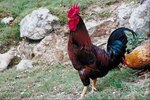Since ancient times, roosters have been used for the blood sport of cockfighting. Due to campaigns by animal welfare and animal rights activists, cockfighting is now illegal in the United States. Advocates of the sport argue that roosters are naturally territorial and aggressive. They protest that the roosters are well cared for and often cite cultural reasons for the preservation of the sport. Animal welfare groups denounce cockfighting as barbaric, arguing the roosters are bred solely for the enhanced aggressive qualities which contradict the bird’s natural state. Stories of roosters pumped full of steroids and forced to fight with blades attached to their legs are often upheld to demonstrate the bloodthirsty aspects of cockfighting. The types of roosters used in these controversial fights varies.
The Cock Pit
Referred to as gamecocks, fighting roosters are put in a ring called a cockpit, where they will fight, until one of them is dead or seriously injured. The roosters are conditioned like professional boxers prior to the fight, which can last anywhere from a few minutes to half-an-hour. Gambling stakes are waged on each of the roosters, and the fight only ends when one of the roosters suffers major trauma or death. Law enforcement agencies in America have found upwards to a hundred thousand dollars on premises where cockfighting is taking place. Almost all roosters seized from cockfights are put down, because they are too aggressive to safely coexist with other birds.
The Fighting Cock
Inadvertently, America has supplied a large number of game fowl to the cockfighting industry. The fighting cock is a prize bird which can sell for as much as five thousand dollars. They are usually selected from the Miner Blues, Hatch, Claret, Black, Round Head or White Hackel breeds. They are prized for their durability, strength, and “no retreat, no surrender” mentality. The fighting cock differs from farm chickens in both size and plumage. In preparation for a fight, the bird’s chest and belly feathers are removed to make it more streamlined and effective. These American breeds are popular in the Dominican Republic, where cockfighting is a legalized tradition and sport. These cocks are idolized and prized by their owners for their profit-making potential. If the cock dies in the fight, it is taken home and eaten for dinner.
The Old English Game
The first fighting breed of rooster to be bred in Britain was the old English game. Renowned for their hardy natures, these roosters had their comb and wattles removed in a process called “dubbing.” After being dubbed, the bird would look more fearsome and be less vulnerable to damage. The old English game rooster is still bred by modern fanciers who continue to dub the birds for show purposes. Left to their own devices, mature old English game cocks will often fight one another to the death, so they are often kept in isolation.
A Reza Asil Cock
The Reza Asil is a large, long-legged rooster from Pakistan and India. Noted for their pugnacity, Asils will often fight for fun as chicks, and to the death when fully mature. Asils posses a distinctive upright stance, drooping tail and well-defined musculature, that marks them as good fighters. Asils are very tame and trusting in regard to humans. Perhaps as a consequence of this, the breed is on the American Livestock Breeds Conservancy’s critical list.
References
- UPC Online: Do Roosters Naturally Fight?
- Oracle Education Foundation: Fighting Chicken.
- Colonial Zone: Cock Fights.
- Associated Press: Cockfighting craze takes wing: The Philippine National Betting Pastime Is Going International
- nimal Care And Regulation: About Cockfighting
- Feathersite.com: Old English Games
Photo Credits
-
Jupiterimages/Photos.com/Getty Images




